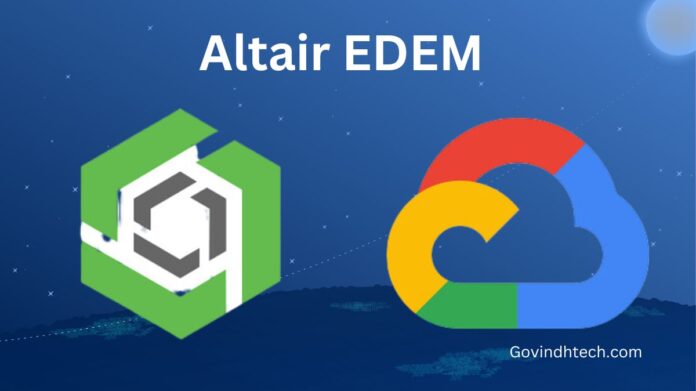Google Cloud and Altair EDEM
An essential skill for manufacturing, industrial, and life science companies is modelling the interactions between bulk and granular materials and containers, machinery, and each other. The more realistic these simulations get, the less time and money businesses need to spend refining their designs and prototypes. Recently, Altair and Google Cloud worked together to see how big of a simulation EDEM Altair could run on a single Google Cloud virtual machine. The outcomes were revolutionary.
Software for the Discrete Element Method (DEM)
High-performance software for simulating both bulk and granular materials is called EDEM. Equipped with DEM, EDEM simulates and analyses a wide range of materials’ behaviours, including coal, mined ores, soils, fibres, grains, tablets, powders, and more, with speed and accuracy.
Engineers may get vital insight into how those materials will behave with their equipment under various operating and process settings by using EDEM modelling. It may be used in conjunction with other CAE tools or on its own.
Using EDEM, top businesses in the heavy equipment, off-road, mining, steel, and process manufacturing sectors can assess equipment performance, optimise workflows, and comprehend and forecast granular material behaviours.
GPUs drive simulations for EDEM
A high-performance software programme for simulating bulk and granular materials is called EDEM Altair. Discrete element method (DEM) simulations and analysis of the behaviour of mined ores, soils, fibres, grains, tablets, powders, and more are performed fast and precisely thanks to EDEM calculations.
Several advancements in model size have been made as a result of industry demands for EDEM to operate at even larger scale. The maximum two decades ago was 200,000 particles, requiring up to ten days to generate in a simulation. That increased swiftly to one million particles, ten million, and finally twenty million. Today, completing a simulation with one billion particles in a few days is the holy grail.
Since these simulations necessitate a significant amount of processing power, as one might anticipate, the use of graphics processing units (GPUs) has significantly increased simulation speed and efficiency. GPUs are extremely effective at handling the massive volumes of data and intricate computations required for EDEM simulations because they are specifically made to handle parallel processing tasks.
The EDEM Altair experiment running on Google Cloud
EDEM was initially intended to be a desktop application and has only ever worked with shared-memory architectures that are hosted on a single host. Unlike distributed memory, which can scale across multiple hosts, this restricts access to processors. EDEM is unable to benefit from the scalability and flexibility of distributed memory without a significant rebuild. On the other hand, multi-GPU systems provide a way to boost processing capacity without switching to distributed memory programming models.
The partnership between Altair and Google Cloud had two objectives: to simulate the largest system that could be created, with one billion particles, and to collect data in order to create estimates for mapping a specific type of hardware to a potential simulation scale. Google Cloud made the announcement that its A3 virtual machines (VMs) with NVIDIA H100 GPUs were now available in May 2023. This level of simulation is made feasible by the A3 VMs, which combine modern CPUs with NVIDIA H100 Tensor Core GPUs and also provide significant network upgrades and enhanced host memory.
Two simulation scenarios were conducted by Altair and Google Cloud on a single A3 virtual machine (VM) equipped with eight NVIDIA H100 GPUs, each having 80 GB of GPU memory and 3.6 TB/s of bisectional bandwidth. A 4th Generation Intel Xeon Scalable processor and 2 TB of host memory were also included in the system.
The filling test was selected as the test scenario. This useful simulation examines the effects of particle behaviour in an actual industrial environment, where particles are dropped into a container from a moving plate. In this simulation, single- and multi-sphere particles were employed.
As previously shown, the combined filing test simulation with single- and multi-sphere EDEM Altair simulations scales well across the eight NVIDIA H100 GPUs that are available, reaching a total particle count of one billion.
The manufacturing industries can now assess equipment performance, optimise processes on a never-before-seen scale, and better understand and predict granular material behaviours thanks to this new breakthrough in simulation technology billion particles which will enable future simulations with greater fidelity and larger scale.
Key points are summarised below:
Importance of Bulk Material Simulation
The behaviour of these materials must be simulated in bulk because it affects many different industries, including manufacturing, life sciences, and industrial processes.
Software called Altair EDEM
Software called EDEM Altair was created especially for high-performance simulation of granular and bulk materials.
Need for Greater Scale
The industry has been requesting that EDEM be able to manage even bigger and more intricate simulations.
Cooperation Goal
Two primary objectives drove the collaboration between Altair EDEM and Google Cloud
- Run the biggest simulation you can, aiming for a billion particles as a benchmark.
- Collect information to determine the possible simulation scale that can be reached with various hardware setups.
Making Use of Google Cloud Hardware
The secret to the success was to leverage the A3 virtual machines (VMs) on Google Cloud, which were outfitted with potent NVIDIA H100 GPUs.
- A3 virtual machines offer the base for general-purpose computing.
- The processing power for high-performance computations is provided by H100 GPUs.
The article discusses utilising eight H100 GPUs, but it makes no mention of the precise A3 VM configuration.

